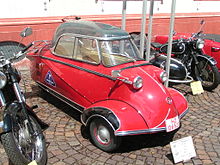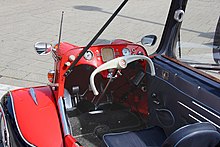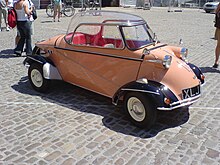Messerschmitt cabin scooter


The Messerschmitt cabin scooter was a scooter mobile by the German designer Fritz M. Fend . The first mobiles were called Fend Flitzer and were manufactured in Rosenheim before series production of the KR 175 began in January 1953 at the Messerschmitt factory in Regensburg (Regensburg steel and metal construction).
history
Fend had initially developed his “Flitzer” as a single-seater with three wheels for the disabled. The first vehicles from 1948 were still driven like a so-called Dutchman by moving the steering lever back and forth, before experiments with a 38 cc bicycle auxiliary motor with a PS from Victoria began. This was soon followed by a drive from Fichtel & Sachs with 98 cm³ and 2.5 hp, 98 of this type, now known as the Flitzer 100 , were built from March 1949 to March 1950. This was followed by the installation of a Riedel engine from the Imme motorcycle with 98 cm³ and 4.5 hp, which helped the vehicle, which was built in 154 units by December 1951, to a top of 75 km / h. With the motorization at the front, the initial bicycle wheels were replaced by wheelbarrow wheels with stronger tires. The first buyer of a Fend Flitzers was a paraplegic from Offenbach . The manufacturer of the first vehicles was Fend Autovermietung GmbH , based in Munich.
From self-employment to Messerschmitt
Good demand suggested that the production of initially ten runabouts a month should be expanded, but there was no money for this. The company was dissolved and in January 1952 Fend followed the advice to turn to the former Messerschmitt aircraft factory, whose production halls were vacant because no aircraft were allowed to be built at that time. However, Willy Messerschmitt was only willing to produce a two-seater in his factory, whereupon corresponding prototypes under the designation FK 150 (Fend cabin scooter) with 150 cm³ Fichtel & Sachs engine were created in mid-1952. In the spring of 1953, the KR 175 was presented at the Geneva Motor Show .
The resulting Messerschmitt cabin scooter had three wheels and two seats arranged one behind the other, so that an unusually narrow, aerodynamically favorable vehicle body could be designed. The two front wheels were steerable. The engine was installed in the rear of the vehicle and drove the rear wheel. The passenger compartment was covered by a plexiglass hood that could be swiveled to one side and was reminiscent of an aircraft cockpit ; the body design was therefore repeatedly referred to as the “Plexiglas full view coupe ”. (The elongated shape of the mobile and the plexiglass hood also led to the joke names “Snow White's coffin” or “Mensch in Aspik ”.) The cabin scooter did not have a steering wheel, but a kind of motorcycle handlebar with a twistgrip that worked directly on the steering knuckles via two tie rods without a steering gear . The actuation of the clutch was initially integrated into the gear lever. Later he got pedals for gas, brakes and clutch. There was an intermediate gear for reversing, which was operated via a lever on the handlebar.
From Messerschmitt to FMR
In connection with government aircraft orders, Willy Messerschmitt had to give up vehicle construction in mid-1956, although he had stated shortly before: “It was always my firm decision to develop vehicles in addition to aircraft construction. The Regensburg plant was set up exclusively for vehicle construction and will remain reserved for this alone in the future. ”(Special supplement“ Messerschmitt ”on the 8 o'clock sheet ) From January 15, 1957, the cabin scooters of the newly founded vehicle and Maschinenbau Regensburg GmbH (FMR) continued production. The company's shareholders were the designer Fritz M. Fend and the manufacturer Valentin Knott.
From 1957 to 1961, the four-wheel "FMR Tg 500" was also manufactured in addition to the KR 200.
The KR 200 with its four variants KR 200 with plexiglass hood , convertible sedan , roadster and sport continued to be built in ever smaller numbers until 1964. It was also offered as a pick-up vehicle that was equipped with a special tow bar. The idea was for a workshop employee to drive the KR to the customer to pick up a car for customer service, and for the return trip to the workshop to couple the cabin scooter to the customer's vehicle like a trailer.
The designer Fritz M. Fend left FMR in January of that year and ran a design office in Regensburg after his partner Valentin Knott had gradually taken over all of his business shares.
In the movie Der Willi-Busch-Report by screenwriter and director Niklaus Schilling from 1979, a KR 200 plays an essential role; A reporter races with him about his experiences on the German-German border. After the fall of the wall, the continuation Deutschfieber was created , in which the reactivated Messerschmitt is on the road again, mainly for expeditions to the GDR.
Messerschmitt KR 175 and KR 200
The KR 175 (KR stands for cabin scooter ) had a single cylinder engine with 173 cm³ displacement and 9 hp from Fichtel & Sachs . That was enough for a top speed of 80 km / h. The daily output was up to 80 vehicles, with an initial retail price of DM 2,100.
At the beginning of 1955, the successor model, the KR 200, appeared with a 10.2 hp engine (191 cm³) and a top speed of around 90 km / h. Like an automobile, the KR 200 had three pedals (clutch, brake, accelerator) and the gear lever with “sequential” ratchet shifting is located on the right-hand side of the vehicle: pull back = downshift, push forward = upshift. The first gear is in the back. To drive in reverse , the two-stroke engine is started in the opposite direction. When the ignition key is inserted and turned, the engine turns clockwise and all four gears can be used to drive forward. When plugging in and simultaneously pressing and turning the ignition key, the engine turns to the left. You can also drive backwards in all gears, theoretically backwards as fast as forwards. A mechanical reverse gear was available at an additional cost.
There was the version with a rhenalon hood, a transparent plastic hood that was rollable. When the weather is nice, the hood should be stowed in the trunk above the engine and, if necessary, installed in a few simple steps. However, it turned out within a very short time that the UV radiation and the heat development in the trunk made the hood lose its elasticity. When trying to roll the hood, the material tore. In a recall campaign , the hoods were exchanged for a version made of Plexiglas. The already printed brochures for the first variant of the KR 200 were not crushed, but the corresponding areas on the back were blackened . In September 1956, the KR 201 appeared as the "economy version" of the KR 200, a roadster version without side windows and with a scissor top for an extra charge.
The contemporary interior was available with imitation snakeskin, various parts were chrome-plated. However, this type of vehicle is rarely seen in the original today. In 1958 a convertible version of the KR 200 appeared. The convertible top was tensioned with three bows and fastened to the hood frame with press studs. You could now drive the vehicle with a plexiglass hood in winter and use a convertible in summer with little effort.
In the same year the entry-level model, the KR 200 Sport, came onto the market. The vehicle did not have a folding entrance or a glass windscreen , so that the vehicle could be offered for a price of DM 2,200. How many of these savings versions were actually sold is unclear, but it is likely to be the rarest version.
For car dealerships, the collection vehicle variant was also launched on the market in 1958. The fitter drove to the customer, installed a tow bar on the bumper of the customer vehicle and on a coupling piece on the left brake anchor plate of the cabin scooter and the route to the dealership could be taken. The cabin scooter in tow was steered by the type of attachment and could be pulled behind without a driver.
Almost 12,000 KR 200 were sold in 1955.
Technical specifications
| Data | KR 175 | KR 200 |
|---|---|---|
| Engine type | 1-cylinder two-stroke | |
| Displacement | 173 cc | 191 cc |
| power | 9 hp (6.6 kW) at 5250 rpm | 10.2 HP (7.5 kW) at 5250 rpm |
| Dimensions L × W × H | 2820 mm × 1220 mm × 1200 mm | |
| wheelbase | 2030 mm | |
| Empty weight without driver | 220 kg | 240 kg |
| construction time | 1953 to 1955 | 1955 to 1964 |
| Prize 1955 | 2,470.00 DM | 2,395.00 DM |
From the instruction manual
The Messerschmitt was probably the only car with instructions for getting in:
“Getting in: Getting in and out of the cabin scooter is a little different than you are used to with other vehicles. Before opening the hood, make sure that there is enough space to the right of the vehicle. Slowly lift the hood and tilt it over to the right until the leather strap is taut.
Well, take a seat as follows:
- Swivel up the seat
- Turn the steering slightly to the right
- Put your right foot in the middle of the vehicle
- Take a seat
- Put your left foot in
- Put both feet forward
Now support with both hands on the sloping side frame tubes and let the seat swivel forward. "
World records with the Messerschmitt KR 200 "Super"
To prove the reliability of the cabin scooter, a Messerschmitt KR 200 set off on August 29, 1955 on the Hockenheimring for a record run of 24 hours. The slightly modified open vehicle called "Super" had only a narrow cockpit opening with a small windshield instead of the standard Plexiglas dome and a so-called head rib behind the driver to reduce air turbulence. Through higher compression and higher speed, the output of the 200 cm³ engine was increased to about 13 hp and the three upper gears were more closely spaced than in the series, so that in second gear about 80, in third 100 and in fourth over 120 km / h were reached. The maximum speed is said to have been 130–140 km / h. In order not to have to interrupt the experiment due to failure and repair of operating parts, the cables for gas, clutch and brake were installed twice. In addition, the vehicle had a 30-liter petrol tank behind the driver and two lead plates under the seat as ballast weighing 60 kg, which was required for the record. Otherwise, the KR 200 “Super” largely corresponded to the series.
Six drivers took turns during the 24-hour drive, among them the designer Fritz Fend and the journalist H. W. Bönsch as well as H. Rathjens, H. Stumm, K. Eisele and H. Schwind. They set 25 records over different distances and times and broke the previous world records in the 350 cm³ class over 1000 miles, over 2000 km and with an average speed of 103 km / h over 24 hours. The record over two hours was set at 108 km / h.
Replica and retro concept
The English manufacturer Tri-Tech, originally a supplier of spare parts, sold a Messerschmitt replica under the name “Schmitt”, available as a kit ( £ 2650 ) or fully assembled (from £ 8800). The "Schmitt KR" had a Honda engine with 250 cm³ displacement. 2010 Tri-Tech no longer existed due to bankruptcy.
The Swedish start-up company Vehiconomics was planning a revival in 2010 with the name “Smite”. The body is made of plastic and the vehicle looks very "retro". Either gasoline or electric motor were provided as the drive. In 2015 Vehiconomics no longer existed.
Tg 500
In 1957 the four-wheeled “FMR Tg 500”, which was presented as the “Tiger”, emerged from the KR. This name could not be used, however, because various animal names such as "Tiger", "Mustang" etc. were protected for the truck series by Krupp (the name "Messerschmitt" was no longer allowed to appear in the type designation). Therefore the vehicle was marketed as FMR Tg 500. Nevertheless, the Tg 500 was generally called the "Tiger".
As a sport version of the cabin scooter, the Tg 500 had appealing driving performance. Powered by a 494 cm³ two-cylinder two-stroke engine from Fichtel & Sachs with 19.9 hp, it reached up to 130 km / h (a Porsche 356 with a 1300 cm³ engine from 1957 was only slightly faster at 145 km / h). The sales price of 3650 DM (1958–1960) or 3725 DM (1961) was, however, quite high, so that only a few copies were built; the figures vary between 320 and 950 pieces (the lower number is to be assumed correct). The Supreme National Sports Commission has not granted the vehicle a motorsport homologation , which requires a number of 400 vehicles. The Tg-500 drivers only drove against each other. Top speed was not the most important thing, but the extraordinary ability in the corners.
Production of the Tg 500 came to an end at the end of 1961.
Technical specifications
| Parameters | FMR Tg 500 |
|---|---|
| Engine: |
Two-cylinder two - stroke engine ( parallel twin ), installed behind the rear axle |
| Cooling : | Air cooling via a belt-driven cooling air fan per cylinder |
| Displacement : | 494 cc |
| Bore × stroke: | 67 mm × 70 mm |
| Compression: | 6.5: 1 |
| Carburetor: | 1 downdraft -Dreistufen- carburetor , Bing 28/07/10 |
| Power: | 19.9 hp (14.6 kW) at 5000 rpm |
| Maximum torque: | 33.3 Nm at 4000 rpm |
| Power transmission: | 4-speed with H-shift, not synchronized, differential, half-axles with length change |
| Front suspension: | Wishbones |
| Rear suspension: | Wishbones |
| Suspension: | Rubber torsion springs at the front, coil springs at the rear; Telescopic shock absorbers |
| Brakes: | hydraulically operated drum brakes |
| Track width front / rear: | 1110/1040 mm |
| Wheelbase : | 1885 mm |
| Turning diameter: | approx. 9.5 m |
| Wheel size: | 4.40-10 |
| Body: | Tubular frame with floor pan; Sheet steel body |
| Length × width × height: | 3000 mm × 1270 mm × 1245 mm |
| Empty weight (fully fueled, without driver): | approx. 390 kg |
| Maximum weight allowed: | 560 kg |
| Consumption: | 5.7 l / 100 km (petrol-oil mixture) |
| Tank capacity: | 30 l |
| Top speed: | approx. 125 km / h |
| Acceleration 0-100 km / h: | approx. 30 s |
| Prize 1961: | 3725 DM 1 |
Depending on the source, the performance data and weight information differ slightly.
1 Adjusted for inflation in today's currency, this corresponds to 8,500 euros, the amount has been rounded to a full 100 euros.
Successor to the Tg 500
In 1994 Tiger Automobile GmbH in Bretten developed the TIGER T1 cabin scooter. The Messerschmitt cabin scooter was the godfather of this new cabin scooter (the Tg of the Marxzell Vehicle Museum was used to approve the shape). It was designed and built using the latest techniques. This exclusive vehicle should be built in a limited number. It was offered for DM 78,000. He had a 1300 cm 3 large 4-cylinder in-line engine from Rover with 64 hp. At around 700 kg, the vehicle was almost twice as heavy as the original (test report Cabrio 4/95). It remained a one-off.
Fend took up the idea of the cabin scooter in a modernized form in the last years of his life. He introduced the Fend 2000 back in the 1980s . However, it stayed with a prototype. After his death the project was completed. Today the unique F2000 is street legal.
Web links
literature
- Hanns-Peter Rosellen: German small cars after 1945: loved, praised and unforgotten . Weltbild Verlag, Augsburg 1991, ISBN 3-89350-040-5 .
- Reinhard Lintelmann: The scooters and small cars of the fifties . Verlag W. Podszun, Brilon 1995, ISBN 3-86133-136-5 .
- Johnny Leyla: Messerschmitt cabin scooter. Mobility for the economic miracle . Komet Verlag, Cologne 2010, ISBN 978-3-89836-954-1 .
Individual evidence
- ^ Hanns Peter Rosellen: German small cars . Weltbild Verlag, Augsburg 1991, ISBN 3-89350-040-5 , pp. 27–32.
- ^ Hanns Peter Rosellen: German small cars. Weltbild Verlag, Augsburg 1991, ISBN 3-89350-040-5 , p. 33.
- ↑ Hans Christoph Graf von Seherr-Thoss , Die deutsche Automobilindustrie , Deutsche Verlags-Anstalt , 1979, page 450
- ↑ In a similar sense: Stadtarchiv Rosenheim, Fritz Fend and his “Flitzer” , accessed on October 21, 2015
- ↑ Dennis Gage: Microcar Show , MyClassicCarTV, YouTube from August 9, 2013
- ↑ FMR KaRo Extrapost. Number 4/59.
- ^ Hanns Peter Rosellen: German small cars. Weltbild Verlag, Augsburg 1991, ISBN 3-89350-040-5 , p. 35.
- ↑ 8 o'clock sheet. Special supplement “Messerschmitt”, Noris-Verlag, Nuremberg 1956 (?), P. 4.
- ↑ Vehicle reports . Accessed September 17, 2011
- ↑ 8 o'clock sheet . Special supplement "Messerschmitt". Noris-Verlag, Nuremberg 1956 (?), P. 3.
- ↑ Schmitt KR, photo (Eng.)
- ↑ Report on the Smite, 3 pictures (Eng.)
- ↑ Motor Classic. Issue 12/1988, p. 107.













